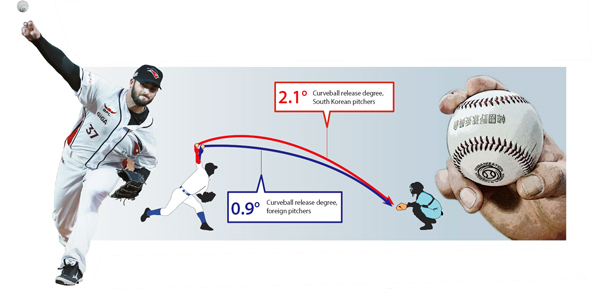Foreign pitchers succeed with the curveball

The average velocity of fastballs by foreign pitchers in 2015 was 146 kilometers per hour (90.7 miles per hour), while that of Korean pitchers was 143 kilometers per hour, essentially a negligible difference.
But speed, while important, is rarely the most telling metric in pitching. The most objective index used to assess a pitcher is whiff rate, a baseball statistic in which the number of pitches batters fail to make contact with is divided by the total number of swings.
Higher whiff rates indicate more effective pitching performances.
For fastballs, the average whiff rate for South Korean pitchers is 6 percent, marginally higher than that of foreign pitchers at 5.6 percent. Korean pitchers also outperform in slugging percentage allowed on balls in play at .507 compared to the .535 recorded by foreign players.
In other words, Korean pitchers have a slight edge with the fastball.
The whiff rate for sliders is also higher for Korean players at 13.5 percent while foreign players’ was marked at 11.2 percent. Sliders are often used as a closing pitch to grab the third strike.
In slugging percentage allowed on balls in play, however, foreign pitchers had a better record at .396, compared to domestic players at .473. Lower slugging percentage allowed on balls in play implies better performance by pitchers.
The bottom line: it’s a toss-up when it comes to which group is more effective with sliders.

For South Korean pitchers, changeups and curveballs take up about 20 percent of their pitches. But for foreign pitchers, they take up about 26 percent - with changeups and curveballs at 13 percent each. Not only do foreign players like to throw them more often, but they are also more effective.
When it comes to changeups, the whiff rate and slugging percentage allowed on balls in play for foreign pitchers stood at 14.3 percent and .422, notably better than Korean pitchers’ 12.1 percent and .480.
An even more significant disparity was seen with curveballs.
In whiff rate, foreign players outpaced domestic players by about 3 percentage points at 13.1 percent compared to 10.5 percent. Particularly, the gap in slugging percentage allowed on balls in play was .115, which is the most in any types of pitches. Foreign pitchers’ slugging percentage allowed on balls in play was .389, but the slugging percentage allowed on balls in play by Korean pitchers was .504.
Essentially, this indicates that one of the core reasons why foreign players pitch more effectively is because of their curveballs.
One interesting difference between the curveballs of South Korean pitchers and foreign pitchers is the release degree.
If a pitcher releases the ball at a higher point, then the release degree of his ball will be higher. Compared to regular fastballs, the release degree of the curveball is usually large. This is because fastballs travel straight, whereas curveballs follow a more winding path. But foreign players release their curveballs as close to regular fastballs as possible, meaning the release degree of their curveballs is similar to that of their fastballs.
There is an inverse correlation between release degree and whiff rate, according to the data provided by TrackMan, a radar detection system installed in all the Major League stadiums.
This means the lower the release rate the higher whiff rate, and by extension, the more effective the pitch.
In 2015, the average curveball release degree of foreign pitchers was 0.9 while for the Korean pitchers it was 2.1, which explains why curveballs by foreign pitchers are more effective.
According to Cha Myeong-joo, a former Hanwha Eagles pitcher who now runs his own pitching academy, Korean players are trained early on to maximize the spin rate of their pitch to create a more dynamic drop, while U.S. pitchers are taught to focus on developing a release mechanism similar to fastballs. South Korean pitchers release the ball at a point near their ears when throwing curveballs, whereas foreign pitchers release farther out in the throwing motion.
Even though the spin rate of balls thrown by Korean pitchers is faster than those by foreign pitchers at 2,400 rotations per minute compared to 2,310, it’s clear that the release point is the more critical factor.
Whenever a new pitching style is introduced in the KBO, such as the two-seam fastball, Korean pitchers rush to learn it. Perhaps it’s time for them to overhaul their basics and look to their foreign counterparts for help on the curveball.
BY SHIN DONG-YUN [choi.hyungjo@joongang.co.kr]










with the Korea JoongAng Daily
To write comments, please log in to one of the accounts.
Standards Board Policy (0/250자)